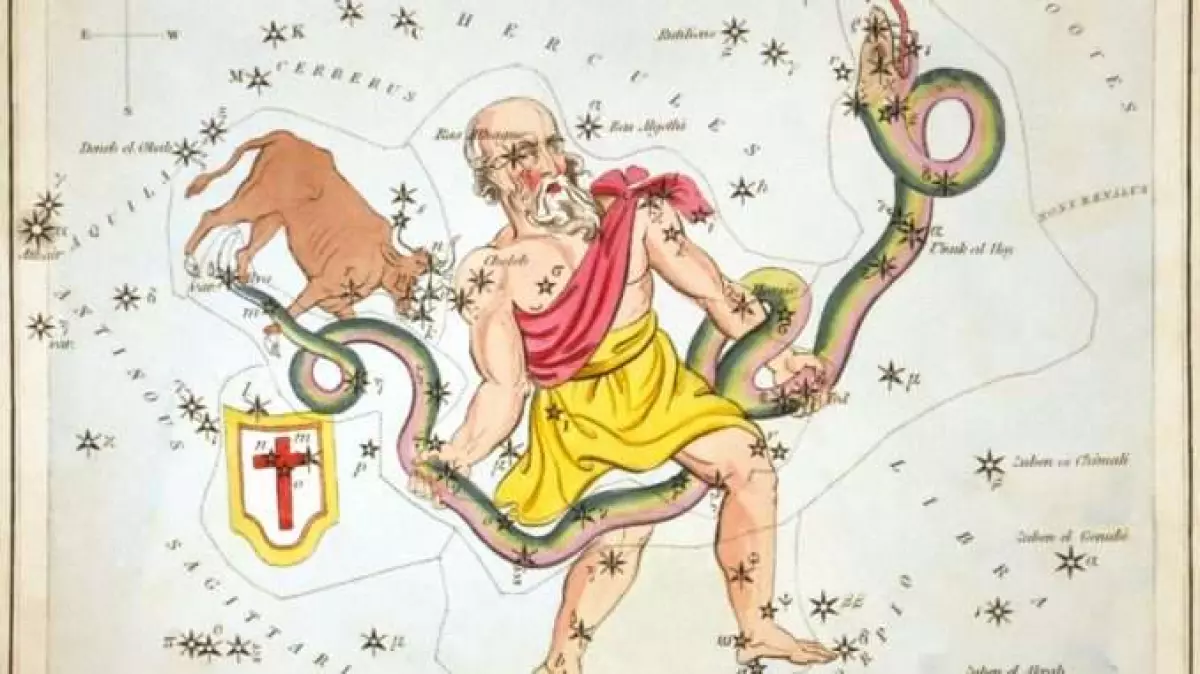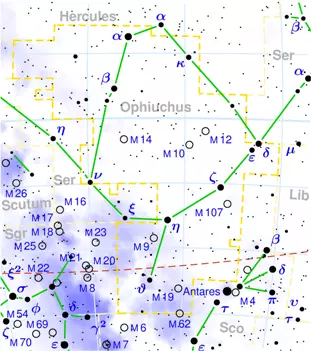 Image Credit: Wikimedia Commons
Image Credit: Wikimedia Commons
Did you know that there is a 13th zodiac sign that has been long forgotten? Welcome to the world of Ophiuchus, the serpent-bearer. In Greek mythology, Ophiuchus is depicted as a man grasping a snake, representing the nearby constellation of Serpens. Despite its significance, Ophiuchus remains a hidden gem in the world of astrology.
Location
Ophiuchus can be observed in the southern sky, between +80° and -80° of latitude. It is the 11th largest constellation, spanning 19 degrees along the ecliptic. Positioned between Scorpius and Sagittarius, Ophiuchus shares its celestial neighborhood with other constellations like Aquila, Hercules, Libra, and Serpens.
Hercules Constellation Family
Ophiuchus is part of the illustrious Hercules family of constellations, which includes Aquila, Ara, Centaurus, Corona Australis, Corvus, Crater, Crux, Cygnus, Hercules, Hydra, Lupus, Lyra, Sagitta, Scutum, Sextans, Serpens, Triangulum Australe, and Vulpecula. These constellations have captivated stargazers for centuries with their majestic beauty.
The Forgotten Zodiac Sign

Surprisingly, astrologers have not officially embraced Ophiuchus as part of the zodiac wheel, despite the Sun spending nineteen days of the year within its boundaries. This omission can be traced back to the origins of the zodiac signs in Mesopotamia, where the sky was divided into 12 equal parts of 30 degrees each. The symmetry of 12 zodiac signs ruling over 12 months appealed to early astrologers, leading to the exclusion of Ophiuchus. However, Ptolemy's influential work, Almagest, recognized Ophiuchus as a significant constellation in 150 AD.
Principal Stars
- Rasalhague: As the brightest star in Ophiuchus, Rasalhague is a captivating binary system. It consists of a white giant being orbited by an orange main sequence dwarf. Located 47 light years away from Earth, Rasalhague shines with a combined visual magnitude of 2.07.
 Image Credit: Mike Simonsen
Image Credit: Mike Simonsen
-
Sabik: This star takes the second spot in terms of brightness within Ophiuchus. Sabik is a binary star system comprising two white main sequence dwarfs. Situated 88 light years away, it gleams with a magnitude of 2.43 and has an orbital period of 87.58 years.
-
Zeta Ophiuchi: The third brightest star in Ophiuchus, Zeta Ophiuchi, is a mesmerizing blue main sequence star located 366 light years away. With a magnitude of 2.569, this Beta Cephei variable star is approximately 3 million years old and spins at a dizzying speed of 400 km/s.
Other noteworthy celestial objects in Ophiuchus include Barnard’s Star, the blue-white supergiant 67 Ophiuchi, the white main sequence dwarf Gamma Ophiuchi, the yellow giant star Yed Posterior (Epsilon Ophiuchi), as well as Celbalrai (Beta Ophiuchi), Sinistra (Nu Ophiuchi), Yed Prior (Delta Ophiuchi), and the red dwarfs GJ 1214 and Wolf 1061.
Notable Deep Sky Objects
Ophiuchus boasts an array of captivating deep sky objects. Among them are the seven Messier objects: M9, M10, M12, M14, M19, M62, and M107. These globular clusters are located between 14,300 and 30,300 light years away. Additionally, Ophiuchus is home to NGC 6240, an ultraluminous infrared galaxy, and several intriguing nebulae such as the Dark Horse Nebula, Little Ghost Nebula, Snake Nebula, Pipe Nebula, and the Twin Jet Nebula.
The supernova explosion of 1604, known as Kepler's Supernova, also occurred in Ophiuchus. This astronomical event observed by Johannes Kepler challenged the Aristotelian dogma of the unchanging nature of the heavens. Kepler's Supernova, seen at a magnitude of −2.5, dazzled observers for almost a month.
The Mythology

Let's delve into the mythology behind Ophiuchus. This constellation honors the ancient medical healer known as Aesclepius in Greek mythology and Imhotep in Egyptian mythology. Aesclepius, the son of Apollo and the mortal princess Coronis, was raised and mentored by the centaur Chiron, who imparted the art of medicine to him. Aesclepius became renowned for his miraculous healing abilities and was given a magical potion by the goddess Athena, made from the blood of the snake-haired Gorgon.
However, Aesclepius offended Zeus by using the potion to bring the dead back to life in exchange for money, disrupting the natural order. As a result, Zeus struck him down with a thunderbolt. Recognizing Aesclepius' positive impact during his lifetime, Zeus honored him by placing him among the stars as the constellation Ophiuchus.
Today, the symbol of medicine is often portrayed as a snake-entwined staff, representing the healing prowess of Aesclepius. It is worth noting that the caduceus, a staff with two snakes, is sometimes mistakenly used as the symbol. The origin of this iconic symbol can be traced back to ancient physicians who used a similar technique to remove "guinea worms" (Dracunculus medinensis) from patients' bodies. Physicians would carefully wind the worm around a stick after making a precise incision. Interestingly, the fear of snakes or reptiles is known as Ophiophobia.
As we explore the wonders of the night sky, let us not forget Ophiuchus, the forgotten zodiac sign. Its rich mythology and awe-inspiring celestial objects make it a captivating constellation deserving of our attention. So, next time you gaze up at the stars, remember to search for the elusive serpent-bearer in the vast expanse of the cosmos.
Note: All image credits belong to their respective creators.







